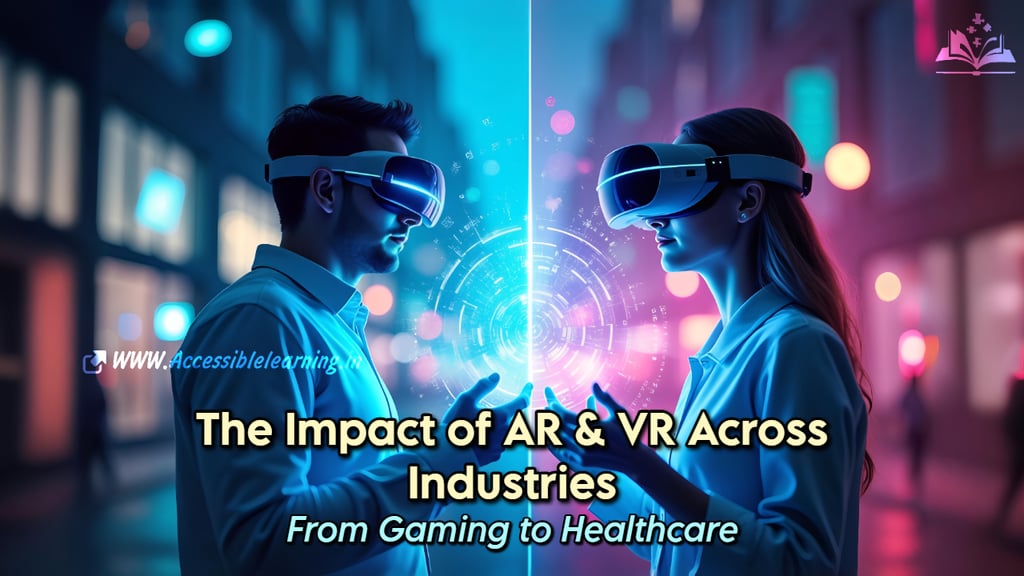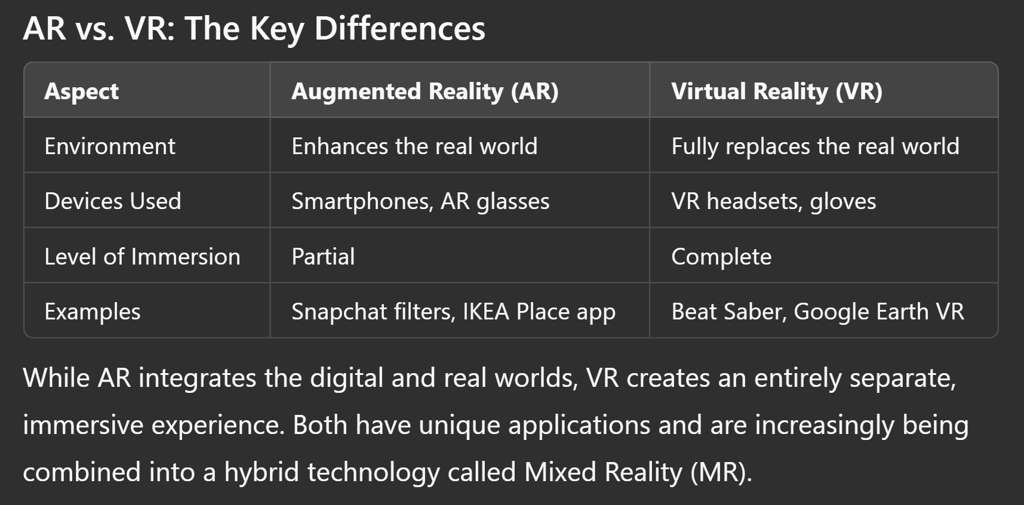
AR & VR: Revolutionizing the Digital and Physical Worlds!
Discover the transformative impact of Augmented Reality (AR) and Virtual Reality (VR) on industries and daily life. Explore their applications, challenges, ethical considerations, and future potential in revolutionizing human-computer interaction.
AI/FUTURECOMPANY/INDUSTRYEDUCATION/KNOWLEDGEARTIST/CREATIVITY
Sachin K Chaurasiya
1/18/20257 min read


Augmented Reality (AR) and Virtual Reality (VR) are not just buzzwords; they are revolutionary technologies reshaping how we perceive and interact with the digital and physical world. These immersive technologies are influencing industries, from entertainment and gaming to healthcare and education. But what exactly are AR and VR, how do they differ, and why are they critical to the future of human-computer interaction? Let’s dive deep.
What is Augmented Reality (AR)?
Augmented Reality (AR) enhances the real-world environment by overlaying digital elements like images, sounds, and other sensory inputs. It doesn’t replace the real world but adds layers of interactive, virtual objects to it. Think of Pokémon GO, where players capture digital creatures superimposed on real-world surroundings.
Key Features of AR
Real-time interaction with digital overlays.
Accessibility through devices like smartphones, tablets, and AR glasses.
Applications in fields like retail (virtual try-ons), healthcare (surgical assistance), and education (interactive learning).
What is Virtual Reality (VR)?
Virtual Reality (VR), on the other hand, immerses users in a fully virtual environment, cutting off the real world. By wearing a VR headset, users are transported into a simulated space, such as a fantasy world, a historical setting, or even a virtual office.
Key Features of VR
Full immersion into a virtual environment.
Requires specialized equipment like VR headsets (e.g., Oculus Quest, HTC Vive).
Applications in gaming, training simulations, virtual tourism, and therapy.


Transforming Industries
Gaming and Entertainment
VR offers unparalleled immersion, making games like Half-Life: Alyx a sensory masterpiece.
AR enhances interactive experiences, such as interactive museum tours or live sports overlays.
Healthcare
AR is being used for surgeries, offering surgeons real-time guidance and overlays of medical images.
VR provides therapy for anxiety disorders, PTSD, and phobias by simulating controlled environments.
Education & Training
AR makes learning interactive, such as overlaying historical information onto landmarks during field trips.
VR provides realistic training simulations for pilots, soldiers, and surgeons.
Retail & E-commerce
AR allows customers to try products virtually. Apps like Sephora Virtual Artist enable users to test makeup without stepping into a store.
Real Estate & Architecture
Virtual tours using VR provide potential buyers with immersive walkthroughs of properties.
AR helps architects visualize projects by overlaying 3D models onto physical spaces.
Manufacturing & Maintenance
AR assists workers by providing real-time guidance for assembling components or repairing machinery.
VR is used for safety training, helping workers practice handling hazardous situations in a risk-free environment.
Travel & Tourism
VR enables virtual travel experiences, allowing users to explore destinations from the comfort of their homes.
AR enhances on-site experiences, providing tourists with historical and cultural context through their devices.
Sports & Fitness
AR apps track performance and overlay data like speed and distance during activities like running or cycling.
VR fitness programs create engaging, immersive workouts that gamify exercise routines.
Revolutionizing Communication and Collaboration
Remote Work
VR creates virtual meeting spaces, allowing colleagues to collaborate as if they were in the same room.
AR enhances video calls by overlaying data and tools directly onto the participant's screen.
Social Interaction
VR social platforms like VRChat enable users to interact with others in virtual spaces, fostering a sense of presence.
AR filters and features in apps like Instagram and Snapchat make online communication more engaging and fun.
The Metaverse Connection
The rise of the metaverse—virtual worlds where people can interact, work, and play—relies heavily on AR and VR technologies. Companies like Meta (formerly Facebook) are heavily investing in creating interconnected digital spaces that blur the lines between AR, VR, and real-world interactions.
Challenges in AR & VR Adoption
Cost Barrier
High-quality AR and VR devices are expensive, limiting widespread adoption.
Technical Limitations
Issues like latency, resolution, and battery life still plague devices, affecting user experience.
Content Development
Creating high-quality AR/VR content is time-consuming and requires specialized skills.
Health Concerns
Extended use of VR can cause motion sickness, eye strain, and fatigue.
Privacy and Security
AR applications that access real-world environments raise privacy concerns, while VR platforms face challenges with secure user data management.
Digital Divide
Not everyone has access to the internet speeds or hardware required for optimal AR/VR experiences, creating a disparity in adoption.
Core Components of AR & VR Systems
Hardware
AR Devices: Smartphones, tablets, smart glasses (e.g., Microsoft HoloLens, Magic Leap), and heads-up displays (HUDs).
VR Devices: VR headsets (e.g., Oculus Quest, HTC Vive, PlayStation VR), motion controllers, haptic feedback devices, and full-body suits.
Sensors and Cameras: Used for motion tracking, spatial mapping, and environment interaction. Key technologies include RGB cameras, LiDAR, and depth sensors.
Software
AR SDKs (Software Development Kits): ARKit (Apple), ARCore (Google), Vuforia, and Wikitude enable developers to build AR applications.
VR Engines: Unity, Unreal Engine, and Amazon Sumerian are widely used for creating immersive VR experiences.
SLAM (Simultaneous Localization and Mapping): Essential for AR, this technology maps the environment in real-time while tracking the user’s location.
Display Technology
AR Displays: Combiner optics (used in smart glasses), projection-based displays, and waveguides.
VR Displays: High-resolution OLED or LCD screens with fast refresh rates (typically 90 Hz or higher) for minimizing motion sickness and latency.
Haptics and Feedback Systems
Haptic Gloves and Suits: Devices like HaptX gloves provide realistic touch and pressure sensations in VR.
Force Feedback Controllers: These simulate resistance, adding realism to interactions in VR environments.
Connectivity
5G Networks: High-speed, low-latency connectivity is critical for cloud-based AR and VR applications.
Bluetooth and Wi-Fi: Used for communication between devices (e.g., VR headsets and controllers).
Advanced AR & VR Technologies
Eye-Tracking Technology
Tracks users’ gaze to enable foveated rendering, which reduces the processing power needed by focusing high-resolution rendering only where the user is looking.
Spatial Audio
Used in VR to create a 3D audio environment, where sounds change based on the user's position and movements.
Cloud AR & VR
Offloads complex computations to the cloud, making applications more accessible on low-power devices.
Examples include platforms like NVIDIA CloudXR for VR streaming.
AI Integration
AI enables smarter interactions, such as real-time object recognition in AR or dynamic NPC behavior in VR games.
It also powers natural language processing for VR assistants and environment personalization.
Machine Learning Models
ML models are used for gesture recognition, predictive analytics, and improving SLAM accuracy.
Mixed Reality (MR)
Combines AR and VR by overlaying virtual objects in a real-world environment with which users can interact naturally.
Devices like Microsoft HoloLens 2 and Meta’s upcoming AR/VR hardware are leading this frontier.
Performance Metrics for AR & VR Systems
Frame Rate: Minimum of 60 FPS for AR and 90 FPS for VR to ensure smooth visuals and reduce motion sickness.
Latency: The ideal latency for VR is less than 20 ms to maintain immersion and reduce discomfort.
Field of View (FoV): VR headsets aim for at least 100-120 degrees to mimic human peripheral vision.
Resolution: Higher pixel density ensures sharper visuals. Modern VR headsets achieve resolutions above 2K per eye.
Degrees of Freedom (DoF):
3DoF: Tracks head rotation only (limited immersion).
6DoF: Tracks both head rotation and positional movement, allowing users to move freely in virtual environments.


Emerging Trends in AR & VR Hardware
Micro-LED Displays: Provide brighter, more energy-efficient visuals for AR and VR devices.
Lightweight Wearables: Companies are developing ultra-light AR glasses and standalone VR headsets.
Inside-Out Tracking: Eliminates the need for external sensors by using cameras on the device to track motion.
Pancake Lenses: Reduce the bulkiness of VR headsets by folding the light path, enabling slimmer designs.
Wireless VR: Standalone headsets like Meta Quest 3 prioritize wireless experiences while maintaining high performance.
Industry-Specific Technical Innovations
Healthcare
AR Surgery Platforms: Tools like AccuVein project veins onto the skin for accurate needle placement.
VR Rehabilitation: Immersive environments help patients regain motor skills post-injury.
Automotive
AR HUDs: Display navigation data and safety alerts directly on windshields.
VR Prototyping: Automakers like BMW use VR to visualize and refine car designs before production.
Retail
AR Shopping Apps: IKEA Place uses AR to let customers visualize furniture in their homes.
VR Stores: Retailers like Alibaba are creating VR shopping malls for virtual browsing.
Education
AR Classrooms: Platforms like Merge Cube bring interactive 3D objects into the classroom.
VR Training: Applications like Labster create simulated lab environments for science students.
Military
AR Tactical Training: Soldiers use AR glasses for battlefield simulations and real-time data overlays.
VR Combat Simulations: Create realistic warzone environments for training scenarios.
Key Challenges in AR & VR Technology
Heat Management: AR and VR devices generate heat during operation, requiring advanced cooling mechanisms.
Battery Efficiency: Improving battery life while maintaining performance is a critical challenge.
Content Compatibility: Ensuring AR/VR apps work seamlessly across devices with different specifications.
Security Protocols: Preventing unauthorized access and ensuring encrypted communication between AR/VR devices.
The Future of AR & VR
The future of AR and VR looks promising, with advances in artificial intelligence (AI), 5G connectivity, and hardware design driving innovation. Key trends include:
Wearable Technology: Lightweight and affordable AR glasses replacing bulky headsets.
Haptic Feedback: Enhanced physical sensations in VR experiences.
AI Integration: Smarter AR applications powered by AI for real-time adjustments.
Cross-industry Collaboration: AR and VR becoming integral to hybrid workspaces, telemedicine, and online education.
Cloud-based AR & VR: Offloading heavy processing to the cloud, enabling more powerful and accessible applications.
Hybrid Reality Environments: The blending of AR and VR into seamless mixed-reality experiences, paving the way for richer interactions.
According to reports, the AR and VR market is expected to surpass $250 billion by 2030, with exponential growth driven by gaming, healthcare, and enterprise applications.
The Ethical Side of AR & VR
Digital Addiction: The immersive nature of VR can lead to excessive use, potentially impacting mental health and social interactions.
Manipulation of Reality: AR can blur the line between what is real and what is fabricated, raising concerns about misinformation and manipulation.
Accessibility: Ensuring these technologies are inclusive and accessible to people with disabilities is essential.
Data Privacy: Protecting user data in immersive environments remains a significant challenge, especially as these systems collect vast amounts of personal information.
Environmental Impact: The manufacturing and disposal of AR/VR devices must be managed sustainably to reduce environmental harm.
Augmented Reality and Virtual Reality are no longer futuristic concepts; they are technologies shaping our present and future. While AR adds value to our real-world experiences, VR takes us to realms we could only dream of. As these technologies evolve, they promise to make human-computer interaction more immersive, intuitive, and impactful. The journey of AR and VR is just beginning, and the possibilities are as limitless as our imagination.
So, whether you’re a gamer, a professional, or simply curious, AR and VR are worlds worth exploring—because the future is immersive!


Subscribe To Our Newsletter
All © Copyright reserved by Accessible-Learning Hub
| Terms & Conditions
Knowledge is power. Learn with Us. 📚


